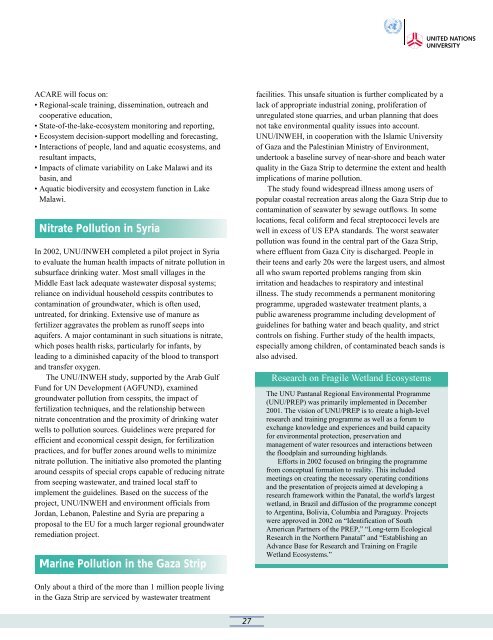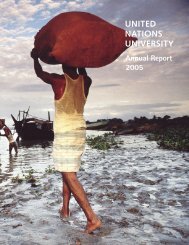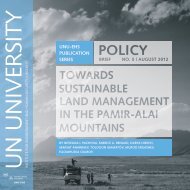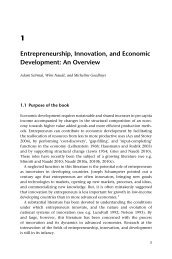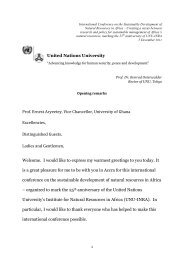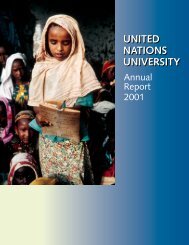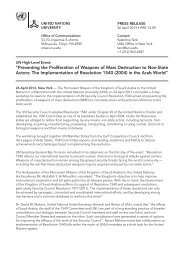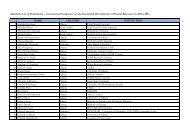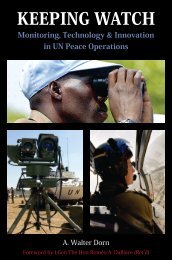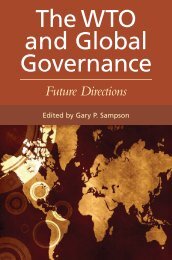Environment and Sustainable Development - United Nations ...
Environment and Sustainable Development - United Nations ...
Environment and Sustainable Development - United Nations ...
Create successful ePaper yourself
Turn your PDF publications into a flip-book with our unique Google optimized e-Paper software.
ACARE will focus on:<br />
• Regional-scale training, dissemination, outreach <strong>and</strong><br />
cooperative education,<br />
• State-of-the-lake-ecosystem monitoring <strong>and</strong> reporting,<br />
• Ecosystem decision-support modelling <strong>and</strong> forecasting,<br />
• Interactions of people, l<strong>and</strong> <strong>and</strong> aquatic ecosystems, <strong>and</strong><br />
resultant impacts,<br />
• Impacts of climate variability on Lake Malawi <strong>and</strong> its<br />
basin, <strong>and</strong><br />
• Aquatic biodiversity <strong>and</strong> ecosystem function in Lake<br />
Malawi.<br />
Nitrate Pollution in Syria<br />
In 2002, UNU/INWEH completed a pilot project in Syria<br />
to evaluate the human health impacts of nitrate pollution in<br />
subsurface drinking water. Most small villages in the<br />
Middle East lack adequate wastewater disposal systems;<br />
reliance on individual household cesspits contributes to<br />
contamination of groundwater, which is often used,<br />
untreated, for drinking. Extensive use of manure as<br />
fertilizer aggravates the problem as runoff seeps into<br />
aquifers. A major contaminant in such situations is nitrate,<br />
which poses health risks, particularly for infants, by<br />
leading to a diminished capacity of the blood to transport<br />
<strong>and</strong> transfer oxygen.<br />
The UNU/INWEH study, supported by the Arab Gulf<br />
Fund for UN <strong>Development</strong> (AGFUND), examined<br />
groundwater pollution from cesspits, the impact of<br />
fertilization techniques, <strong>and</strong> the relationship between<br />
nitrate concentration <strong>and</strong> the proximity of drinking water<br />
wells to pollution sources. Guidelines were prepared for<br />
efficient <strong>and</strong> economical cesspit design, for fertilization<br />
practices, <strong>and</strong> for buffer zones around wells to minimize<br />
nitrate pollution. The initiative also promoted the planting<br />
around cesspits of special crops capable of reducing nitrate<br />
from seeping wastewater, <strong>and</strong> trained local staff to<br />
implement the guidelines. Based on the success of the<br />
project, UNU/INWEH <strong>and</strong> environment officials from<br />
Jordan, Lebanon, Palestine <strong>and</strong> Syria are preparing a<br />
proposal to the EU for a much larger regional groundwater<br />
remediation project.<br />
Marine Pollution in the Gaza Strip<br />
facilities. This unsafe situation is further complicated by a<br />
lack of appropriate industrial zoning, proliferation of<br />
unregulated stone quarries, <strong>and</strong> urban planning that does<br />
not take environmental quality issues into account.<br />
UNU/INWEH, in cooperation with the Islamic University<br />
of Gaza <strong>and</strong> the Palestinian Ministry of <strong>Environment</strong>,<br />
undertook a baseline survey of near-shore <strong>and</strong> beach water<br />
quality in the Gaza Strip to determine the extent <strong>and</strong> health<br />
implications of marine pollution.<br />
The study found widespread illness among users of<br />
popular coastal recreation areas along the Gaza Strip due to<br />
contamination of seawater by sewage outflows. In some<br />
locations, fecal coliform <strong>and</strong> fecal streptococci levels are<br />
well in excess of US EPA st<strong>and</strong>ards. The worst seawater<br />
pollution was found in the central part of the Gaza Strip,<br />
where effluent from Gaza City is discharged. People in<br />
their teens <strong>and</strong> early 20s were the largest users, <strong>and</strong> almost<br />
all who swam reported problems ranging from skin<br />
irritation <strong>and</strong> headaches to respiratory <strong>and</strong> intestinal<br />
illness. The study recommends a permanent monitoring<br />
programme, upgraded wastewater treatment plants, a<br />
public awareness programme including development of<br />
guidelines for bathing water <strong>and</strong> beach quality, <strong>and</strong> strict<br />
controls on fishing. Further study of the health impacts,<br />
especially among children, of contaminated beach s<strong>and</strong>s is<br />
also advised.<br />
Research on Fragile Wetl<strong>and</strong> Ecosystems<br />
The UNU Pantanal Regional <strong>Environment</strong>al Programme<br />
(UNU/PREP) was primarily implemented in December<br />
2001. The vision of UNU/PREP is to create a high-level<br />
research <strong>and</strong> training programme as well as a forum to<br />
exchange knowledge <strong>and</strong> experiences <strong>and</strong> build capacity<br />
for environmental protection, preservation <strong>and</strong><br />
management of water resources <strong>and</strong> interactions between<br />
the floodplain <strong>and</strong> surrounding highl<strong>and</strong>s.<br />
Efforts in 2002 focused on bringing the programme<br />
from conceptual formation to reality. This included<br />
meetings on creating the necessary operating conditions<br />
<strong>and</strong> the presentation of projects aimed at developing a<br />
research framework within the Panatal, the world's largest<br />
wetl<strong>and</strong>, in Brazil <strong>and</strong> diffusion of the programme concept<br />
to Argentina, Bolivia, Columbia <strong>and</strong> Paraguay. Projects<br />
were approved in 2002 on “Identification of South<br />
American Partners of the PREP,” “Long-term Ecological<br />
Research in the Northern Panatal” <strong>and</strong> “Establishing an<br />
Advance Base for Research <strong>and</strong> Training on Fragile<br />
Wetl<strong>and</strong> Ecosystems.”<br />
Only about a third of the more than 1 million people living<br />
in the Gaza Strip are serviced by wastewater treatment<br />
27


